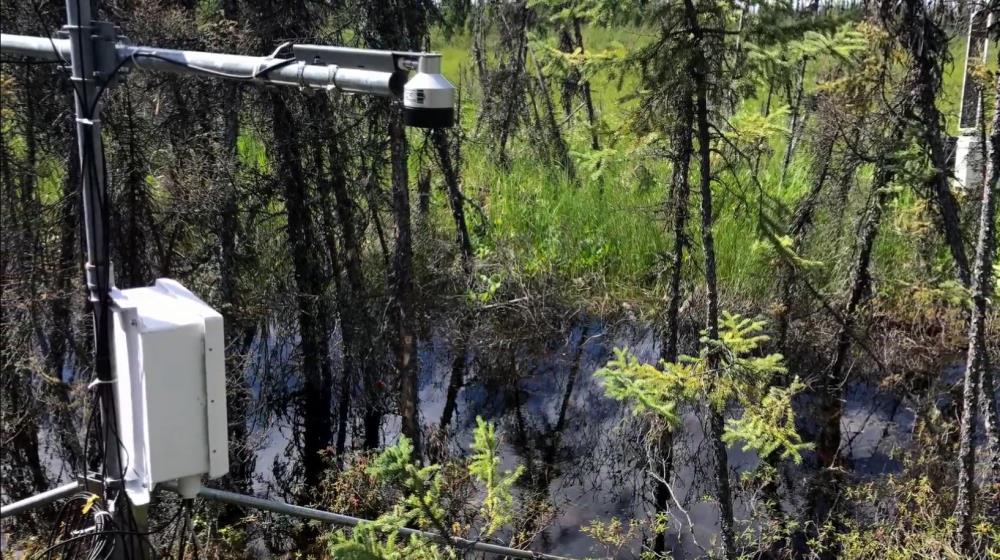
Related items loading ...
Section 1: Publication
Publication Type
Conference Poster
Authorship
Huang Xiang, Weng David L. Rudolph Jiaqi
Title
Thermal-hydraulic-mechanical-chemical modelling in a permafrost-affected groundwater system
Year
2022
Publication Outlet
AOSM2022
DOI
ISBN
ISSN
Citation
Xiang Huang, David L. Rudolph and Jiaqi Weng (2022). Thermal-hydraulic-mechanical-chemical modelling in a permafrost-affected groundwater system. Proceedings of the GWF Annual Open Science Meeting, May 16-18, 2022.
Abstract
The continuous growing interest for predicting the dynamics of the thermal regime and groundwater flow systems subjected to freeze-thaw cycles is enhancing the need for a more comprehensive understanding of the integration and feedback among the thermal, hydraulic, mechanical, and chemical fields. This is of particular significance in discontinuous permafrost terrain under a changing climate. However, predicting those behaviours in permafrost-affected groundwater systems is challenging due to the inherent nonlinear interactions and coupling between subsurface mass and energy transport processes. Here we present a fully coupled thermal-hydraulic-mechanical-chemical (THMC) model, which includes heat conduction and convection, water-ice phase change, groundwater flow driven by pressure and thermal gradients (cryosuction), linear elastic stress-strain relationships, and solute transport with adsorption. This THMC model framework is first validated by lab experimental measurements from literature and then applied to an idealized aquifer system within a discontinuous permafrost environment in which groundwater flow is driven by topography. Simulations show the impact of climate warming scenarios on permafrost distribution, groundwater discharge to surface water bodies, frost heave and thaw settlement, and the transport of conservative, yet sorptive solutes over timescales of decades to centuries. Our simulation results showed that i) disappearance of residual permafrost significantly changed groundwater and thermal flow paths and enhanced base flow to stream/rivers; ii) the magnitude of thawing front moving rate in supra-permafrost is significantly higher than that in the sub-permafrost; and iii) the thawing-induced settlement/consolidation and solute-affected early thawing behaviour (lower freezing point) cause non-linear evolution trends of the increasing groundwater discharge as well as the solute mass flux to streams. These insights into changing patterns of groundwater dynamics, thermal regime, discontinuous terrain deformation and contaminant transport behaviour will help explain observed changes in arctic landscapes and are crucial for examining northern water cycles.
Plain Language Summary
The partitioning of precipitation between rainfall and snowfall is a crucial component of the evolution of the snowpack in mountains. Most snowpack models use the air temperature and humidity near the surface to derive the precipitation phase. However, the phase at the surface is strongly influenced by processes such as melting and refreezing of falling hydrometeors that occur above the surface. Atmospheric models simulate these processes and the corresponding phase at the surface. However, snowpack models rarely use this information. In this study, we considered two estimates of precipitation phase from an atmospheric model and tested them with a physically-based snow model over the mountains of southwestern Canada and northwestern United States. The results were compared with traditional approaches using the air temperature and humidity near the surface to derive the precipitation phase. Our results showed that the precipitation phase associated with the snow level obtained from the atmospheric model improved snowfall estimate and snowpack prediction compared to the traditional approaches. In contrast, the cloud/precipitation scheme of the atmospheric model decreased performance in phase estimate and snow simulations due to missing physical processes. Our study highlights that snowpack predictions in the mountains can be improved if valuable information is obtained from atmospheric models.
Section 2: Additional Information
Program Affiliations
Project Affiliations
Submitters
|
xiang huang | Submitter/Presenter | xiang.huang@uwaterloo.ca | University of Waterloo |
Publication Stage
N/A
Theme
Hydrology and Terrestrial Ecosystems
Presentation Format
poster presentation
Additional Information
AOSM2022 Northern Water Futures/core modelling team First Author: Xiang Huang, University of Waterloo Additional Authors: David L. Rudolph and Jiaqi Weng, University of Waterloo


 GWFNet
GWFNet Master
Master Data
Data Research
Research Map
Map
 Advanced
Advanced Tools
Tools
 . . .
. . .
 Metadata Editor
Metadata Editor
 Record List
Record List
 Alias List Editor
Alias List Editor
 Legacy sites
Legacy sites